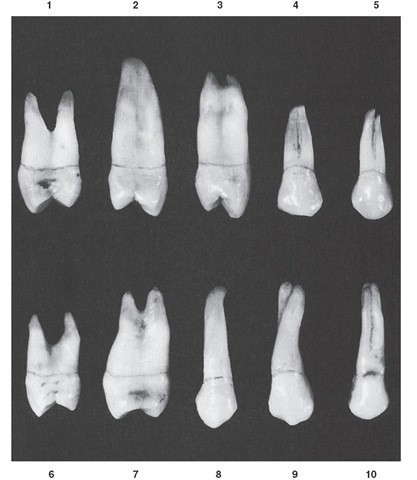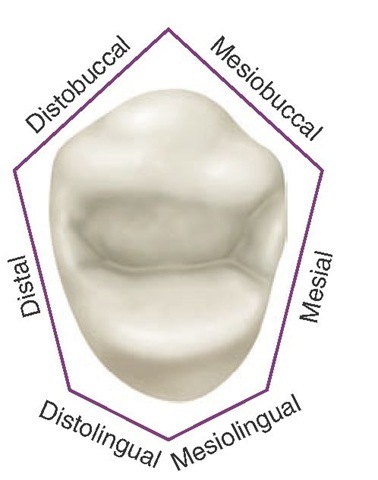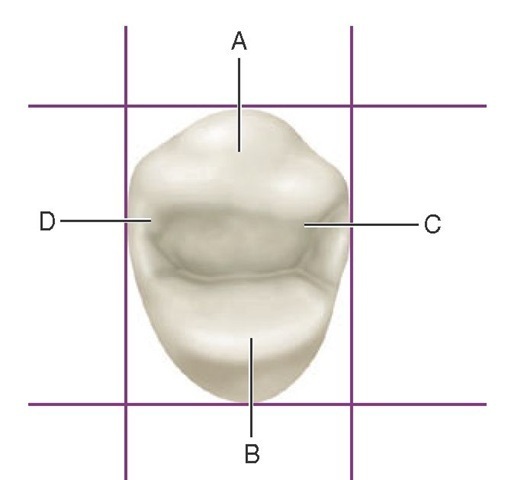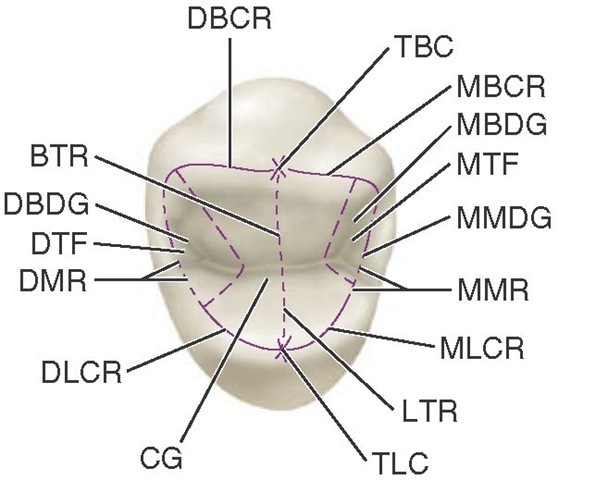Lingual Aspect
From the lingual aspect, the gross outline of the maxillary first premolar is the reverse of the gross outline from the buccal aspect (see Figures 9-3, 9-7, and 9-8).
The crown tapers toward the lingual because the lingual cusp is narrower mesiodistally than the buccal cusp. The lingual cusp is smooth and spheroidal from the cervical portion to the area near the cusp tip. The cusp tip is pointed, with mesial and distal slopes meeting at an angle of about 90 degrees.
Naturally, the spheroidal form of the lingual portion of the crown is convex at all points. Sometimes the crest of the smooth lingual portion that terminates at the point of the lingual cusp is called the lingual ridge.
The mesial and distal outlines of the lingual portion of the crown are convex; these outlines are continuous with the mesial and distal slopes of the lingual cusp and straighten out as they join the mesial and distal sides of the lingual root at the cervical line.
The cervical line lingually is regular, with slight curvature toward the root and the crest of curvature centered on the root. Because the lingual portion of the crown is narrower than the buccal portion, it is possible to see part of the mesial and distal surfaces of crown and root from the lingual aspect, depending on the posing of the tooth and the line of vision.
Because the lingual cusp is not as long as the buccal cusp, the tips of both cusps, with their mesial and distal slopes, may be seen from the lingual aspect.
The lingual portion of the root, or the lingual portion of the lingual root if two roots are present, is smooth and convex at all points. The apex of the lingual root of a two-root specimen tends to be more blunt than the buccal root apex.
Mesial Aspect
The mesial aspect of the crown of the maxillary first premolar is also roughly trapezoidal (see Figures 9-1, 9-4, 9-7, 9-8, and 9-10). However, the longest of the uneven sides is toward the cervical portion and the shortest is toward the occlusal portion (see Figure 4-16, E).
FIGURE 9-13 Maxillary first premolar. Ten specimens with uncommon variations are shown. 1, Constricted occlusal surface; short roots. 2, Single root of extreme length. 3, Constricted occlusal surface; mesial developmental groove indistinct on mesial surface of root. 4, Short root form, with two buccal roots fused. 5, Short root form, with two buccal roots showing bifurcation. 6, Short roots, with considerable separation. 7, Buccolingual calibration greater than usual. 8, Root extremely long; distal contact area high. 9, Twisted buccal root. 10, Three roots fused; roots are also uncommonly long.
FIGURE 9-14 Maxillary first premolar, occlusal aspect. This aspect resembles a hexagonal figure.
FIGURE 9-15 Maxillary first premolar, occlusal aspect. A, Crest of buccal ridge; B, crest of lingual ridge; C, crest of mesial contact area; D, crest of distal contact area.
FIGURE 9-16 Maxillary first premolar, occlusal aspect. TBC, Tip of buccal cusp; MBCR, mesiobuccal cusp ridge; MBDG, mesiobuccal developmental groove; MTF, mesial triangular fossa; MMDG, mesial marginal developmental groove; MMR, mesial marginal ridge; MLCR, mesiolingual cusp ridge; LTR, lingual triangular ridge; TLC, tip of lingual cusp; CG, central groove; DLCR, distolingual cusp ridge; DMR, distal marginal ridge; DTF, distal triangular fossa; DBDG, distobuccal developmental groove; BTR, buccal triangular ridge; DBCR, distobuccal cusp ridge.
Another characteristic that is representative of all posterior maxillary teeth is that the tips of the cusps are well within the confines of the root trunk. (For a definition of root trunk, see Figures 11-3 and 11-8.) In other words, the measurement from the tip of the buccal cusp to the tip of the lingual cusp is less than the buccolingual measurement of the root at its cervical portion.
Most maxillary first premolars have two roots, one buccal and one lingual; these are clearly outlined from the mesial aspect.
The cervical line may be regular in outline (see Figure 9-10, 1) or irregular (see Figure 9-10, 4). In either case, the curvature occlusally is less (about 1 mm on the average) than the cervical curvature on the mesial of any of the anterior teeth. The extent of the curvature of the cervical line mesially on these teeth is constant within a fraction of a millimeter and is similar to the average curvature of the mesial of all posterior teeth.
From the mesial aspect, the buccal outline of the crown curves outward below the cervical line. The crest of curvature is often located approximately at the junction of cervical and middle thirds; however, the crest of curvature may be located within the cervical third (see Figure 9-10, 1 and 10). From the crest of curvature, the buccal outline continues as a line of less convexity to the tip of the buccal cusp, which is directly below the center of the buccal root (when two roots are present).
The lingual outline of the crown may be described as a smoothly curved line starting at the cervical line and ending at the tip of the lingual cusp. The crest of this curvature is most often near the center of the middle third. Some specimens show a more abrupt curvature at the cervical third (see Figure 9-10, 2 and 9).
The tip of the lingual cusp is on a line, in most cases, with the lingual border of the lingual root. The lingual cusp is always shorter than the buccal cusp, the average difference being about 1 mm. This difference, however, may be greater (see Figure 9-10, 1, 4, and 10). From this aspect, it is noted that the cusps of the maxillary first premolar are long and sharp, with the mesial marginal ridge at about the level of the junction of the middle and occlusal thirds.
A distinguishing feature of this tooth is found on the mesial surface of the crown. Immediately cervical to the mesial contact area, centered on the mesial surface and bordered buccally and lingually by the mesiobuccal and mesiolingual line angles, is a marked depression called the mesial developmental depression (see Figure 9-1). This mesial concavity continues apically beyond the cervical line, joins a deep developmental depression between the roots, and ends at the root bifurcation. On single-root specimens, the concavity on the crown and root is also plainly seen, although it may not be as deeply marked. Maxillary second premolars do not have this feature (see Figure 9-11, A and B).
Another distinguishing feature of the maxillary first premolar is a well-defined developmental groove in the enamel of the mesial marginal ridge. This groove is in alignment with the developmental depression on the mesial surface of the root but is not usually connected with it. This marginal groove is continuous with the central groove of the occlusal surface of the crown, crossing the marginal ridge immediately lingual to the mesial contact area and terminating a short distance cervical to the mesial marginal ridge on the mesial surface (see Figure 9-10, 10).
The buccal outline of the buccal root, above the cervical line, is straight, with a tendency toward a lingual inclination. On those buccal roots having a buccal inclination above the root bifurcation, the outline may be relatively straight up to the apical portion of the buccal root or it may curve buccally at the middle third. Buccal roots may take a buccal or lingual inclination, apical to middle thirds.
The lingual outline of the lingual root is rather straight above the cervical line. It may not exhibit much curvature between the cervix and the apex. Many cases, however, show considerable curvature to lingual roots apical to the middle thirds. The lingual root may take a buccal or lingual inclination (see Figure 9-10, 1, 2, and 9).
The root trunk is long on this tooth, making up about half of the root length. The bifurcation on those teeth with two roots begins at a more occlusal point mesially than distally. Generally speaking, when bifurcated, the root is bifurcated for half its total length.
Except for the deep developmental groove and depression at or below the bifurcation, the mesial surface of the root portion of this tooth is smoothly convex buccally and lingually. Even when only one root is present, the developmental depression is very noticeable for most of the root length. In such cases, roots with buccal and lingual outlines ending in a blunt apex above the center of the crown are seen (see Figure 9-10, 4 and 5).
Distal Aspect
From the distal aspect (see Figures 9-5, 9-7, and 9-8), the anatomy of the crown and root of the maxillary first premolar differs from that from the mesial aspect as follows:
• The crown surface is convex at all points except for a small, flattened arc just cervical to the contact area and buccal to the center of the distal surface.
• The curvature of the cervical line is less on the distal than on the mesial surface, often showing a line straight across from buccal to lingual.
• A deep developmental groove crossing the distal marginal ridge of the crown is not evident. If a developmental groove should be noticeable, it is shallow and insignificant.
• The root trunk is flattened on the distal surface above the cervical line with no outstanding developmental signs.
• The bifurcation of the roots is abrupt near the apical third, with no developmental groove leading to it such as that found mesially.
Occlusal Aspect
The occlusal aspect of the maxillary first premolar resembles roughly a six-sided or hexagonal figure (see Figures 9-7, 9-8, 9-12, and 9-14). The six sides are made up of the mesiobuc-cal, which is mesial to the buccal ridge; mesial; mesiolingual, which is mesial to the lingual ridge; distolingual; distal; and distobuccal. This hexagonal figure, however, is not equilateral. The two buccal sides are nearly equal, the mesial side is shorter than the distal side, and the mesiolingual side is shorter than the distolingual side (see Figure 9-14).
The relation and position of various anatomical points are to be considered from the occlusal aspect. A drawing of the outline of this occlusal aspect, when placed within a rectangle the dimensions of which represent the mesiodistal and buccolingual width of the crown, demonstrates the relative positions of the mesial and distal contact areas and also those of the buccal and lingual ridges (see Figures 9-6 and 9-15).
The crest of the distal contact area is somewhat buccal to that of the mesial contact area, and the crest of the buccal ridge is somewhat distal to that of the lingual ridge. The crests of curvature represent the highest points on the buccal and lingual ridges and the mesial and distal contact areas.
Close observation of the crown from this aspect reveals the following characteristics (see Figure 9-15):
1. The distance from the buccal crest (A in Figure 9-15) to the mesial crest (C) is slightly longer than the distance from the buccal crest to the distal crest (D).
2. The distance from the mesial crest to the lingual crest is much shorter than the distance from the distal crest to the lingual crest.
3. The crown is wider on the buccal than on the lingual.
4. The buccolingual dimension of the crown is much greater than the mesiodistal dimension.
The occlusal surface of the maxillary first premolar is circumscribed by the cusp ridges and marginal ridges. The mesiobuccal and distobuccal cusp ridges are in line with each other, and their alignment is in a distobuccal direction. In other words, even though they are in the same alignment, the distobuccal cusp ridge is buccal to the mesiobuccal cusp ridge (see Figure 9-16).
The angle formed by the convergence of the mesiobuccal cusp ridge and the mesial marginal ridge approaches a right angle. The angle formed by the convergence of the distobuccal cusp ridge and the distal marginal ridge is acute. The mesiolingual and distolingual cusp ridges are confluent with the mesial and distal marginal ridges; these cusp ridges are curved, following a semicircular outline from the marginal ridges to their convergence at the tip of the lingual cusp.
When one looks at the occlusal aspect of the maxillary first premolar, posing the tooth so that the line of vision is in line with the long axis, more of the buccal surface of the crown is seen than of the lingual surface. When the tooth is viewed from the mesial aspect, the tip of the buccal cusp is nearer the center of the root trunk than is the lingual cusp.
The occlusal surface of this tooth has no supplemental grooves in most cases, a fact that makes the surface relatively smooth. A well-defined central developmental groove divides the surface evenly buccolingually. It is located at the bottom of the central sulcus of the occlusal surface, extending from a point just mesial to the distal marginal ridge to the mesial marginal ridge, where it joins the mesial marginal development groove. This latter groove crosses the mesial marginal ridge and ends on the mesial surface of the crown (see Figures 9-1 and 9-4).
Two collateral developmental grooves join the central groove just inside the mesial and distal marginal ridges. These grooves are called the mesiobuccal developmental groove and the distobuccal developmental groove. The junctions of the grooves are deeply pointed and are named the mesial and distal developmental pits.
Just distal to the mesial marginal ridge, the triangular depression that harbors the mesiobuccal developmental groove is called the mesial triangular fossa. The depression in the occlusal surface, just mesial to the distal marginal ridge, is called the distal triangular fossa.
Although no supplemental grooves are present in most instances, smooth developmental depressions may be visible radiating from the central groove and giving the occlusal surface an uneven appearance.
The buccal triangular ridge of the buccal cusp is prominent, arising near the center of the central groove and converging with the tip of the buccal cusp. The lingual triangular ridge is less prominent; it also arises near the center of the central groove and converges with the tip of the lingual cusp.
The lingual cusp is pointed more sharply than the buccal cusp.




